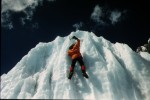So who won tickets to see the Everest IMAX film?
(In association with the National Museum of Science and Industry)
If you haven't seen the David Brashears film about climbing Everest, made using the IMAX format - the biggest and most impressive film format ever - then you could be in for a treat. Shot in 1996, the project also documented how vicious the mountain can be, when eight people on a separate expedition died while returning from the summit after taking the south route to the top.
The IMAX format uses a huge screen - the one in London is 20m high and 26m wide. It is without a doubt an experience which makes you feel that you are there - one scene, filmed while abseiling in space on a twisting rope, is virtually guaranteed to make your head spin too.
The Science Museum offered FIVE pairs of tickets (normal cost £7.10) to see the film at the IMAX cinema in London.
But first (in the manner of Chris Tarrant with a non-coughy contestant) you had to answer these questions:
| Q. There are two "standard" routes up Everest - the North, and the South. Which is generally thought the more difficult? |
 © IMAX If you'd looked a little further down, to the sixth separate result on that page, you'd have realised that it's the south. Fact is, the North route is generally seen as the "climber's" (or at least mountaineer's") option. And no, Lisa Hodges and Georgia Cleary and Susan Hodges, sorry, but typing it in CAPITALS does not make the NORTH ridge the easier one. But as you got the same answer wrong in every single one of your (collectively) 20 answers, we're beginning to wonder if you're not just the same person many times. Even so we were amazed and slightly concerned that this was the question that the most people got wrong: of 71 wrong answers, only 4 got this one right but the camera weight (the next question) wrong. |
| Q. How much did the IMAX camera that David Brashears took to the Everest summit weigh? |
 © IMAX If you read the 1996 summit journal for June 12 written by Ed Viesturs, he's asked "So each time the camera stopped to film, did the camera have to be assembled? Was there a long routine with that?", he replies: "...we tried to take all of that off after each shot to make the camera as light as possible and it still weighed about 30 or 35 pounds just on its own." In new money, 30-35lb is 13.6-15.9kg. But if you then read this HowStuffWorks page, it says the camera weighs 42lb, or about 21kg if you include the weight of the film. On this question, we accepted any answer from 30lb (13.6kg) to 42lb (21kg), because it was easy to interpret it differently. Lots of people got this question right - almost all opting for the 42lb answer. |
| Q. Name the first two people known to have summitted Everest. |
 © IMAX |
In the end we had 89 entries, of which 18 were correct from 11 different people. But only five could win - and our random number selector chose Martin Waterhouse, Alison Lyndon, Paul O'Sullivan, Ewan Whitney and Jules Ganley. Congratulations to them, and thanks to everyone who entered - you're what makes competitions work (and gets companies to offer stuff for competitions, so it all works out to everyone's benefit in the end). And if you didn't win, don't forget that you can see it by paying: just go to the Science Museum website for details. It is truly worthwhile. --Charles Arthur
Comments